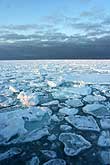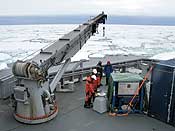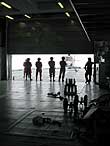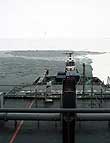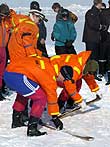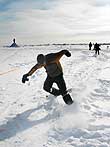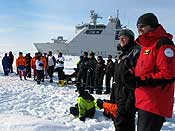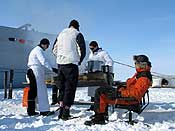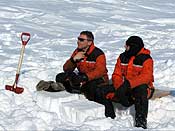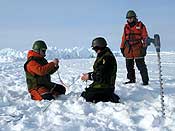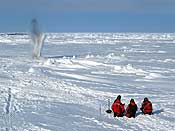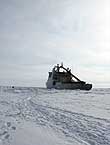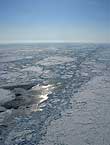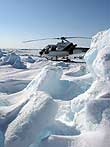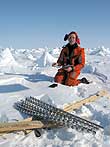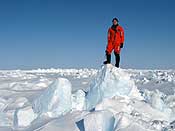Another update
We’ve been busier than usual the last couple of days, collecting temperature and salinity measurements as well as water samples from the deep. The weather although calm has also been quite dull, so I haven’t really had the inclination to take many pictures. However, while I was on the phone last night after finishing work the sky cleared up to leave a great sunset with the last few clouds just disappearing over the horizon. I took the first two photos at about half past midnight – they show just how light it still was!
We were back to work bright and early this morning though but the clear skies of the night before were just a memory and we had a fairly chilly day. The blue thing under tarpaulin in the picture below is a winch with three and a half kilometers of wire on it that allows us to lower instruments to the bottom and to take samples. The crane itself has only a little bit of wire and just holds a pulley over the side of the ship, so it takes a well co-ordinated crane and winch driving to swing things over the side! After the instrument package is in the water the crane driver can go and have a coffee and I can safely control the winch from my computer (USB winch anyone?) which is situated in the nicely heated and insulated shipping container just visible on the extreme right. Being inside is a good thing as it takes about two hours to lower the instruments down to the bottom and back, but it doesn’t have any windows so it’s a bit sad to be stuck in there on a nice day.
It takes such a long time to lower the instruments because although the package is very heavy in air it doesn’t weigh so much in the water. If we veer too quickly there will be no tension on the cable and it can loop and snag around itself in the water – or snatch as the ship rolls, which places enormous strain on the winch. Once the package begins to get deeper though we can speed up as the weight of all that wire hanging over the side maintains enough tension.
A couple of days ago while we were out at sea an unexpected roll, caused the tension to go very low and the wire got a loop in it, which then snatched tight. The cable survived, but the strands were horribly twisted and unravelled close to where the loop was so we had to cut it off at that point! The Norwegian term for this occurrence is getting ‘an Englishman’ in the wire. No one seems to know where the expression comes from though. I’m just glad this Englishman wasn’t driving at the time or there might have been a few jokes….
When the water is more than about a kilometer deep we can’t actually tell how deep it is using the echo sounder on the ship, because the speed of sound is influenced by the temperature of the water. We mustn’t lower the instrument package to the seabed as the ship will be drifting at up to a knot and the bottom may have nasty sharp rocks (or at least disgusting mud). To avoid hitting the bottom we have an altimeter on the instrument package that tells us how far away the seabed is, but it can only see about 80 meters – so we have to watch it carefully! Whats more when the package is it a depth of 3 km we might have let out as much as 3.5km of wire because the package drifts sideways a bit. Our deepest samples however come from only 5 meters above the seabed, so we have to wind the package up pretty quickly after we get them in case it pendulums downwards, or the ship drifts into shallower water. One final hazard to keep in mind while we’re doing this is that the end of the wire is not actually attached to the middle of the winch!!! There is so much strain on the wire if the ship rolls quickly that it’s just not possible to fix it there strongly enough… Instead it is simply held in place by always leaving a number of wraps of wire around the winch! If the current/wind is strong we can’t reach the bottom with the 3.5km of wire we have due to drift, so we have to remember to stop before we let it go like a kid losing a very expensive balloon. This idea terrifies me when we’re working late!
Anyways the joys of deep sampling are over for the first half of this cruise as we are now up on the East Greenland Shelf which is only about 250 m deep. The ice is also getting too thick for the ship, so we will continue to do out sampling using a small winch that we can take in the helicopter and lower small instruments over the side of ice floes. I’m including a couple of pictures of the helicopter hanger and the helicopter taking off. As you can see the weather is still a little grey….
My boss calls the guys lined up along the front of the hanger the ‘bug-men’ due to their funky helmets – you can see them better in some previous photos. I think they look quite cool, but I’m not exactly sure what their role is. They’re always just standing there observing us take off. Apparently if it gets really rough, and the ship rolls too much for the helicopter to land normally, it has to lower a cable and be pulled out of the air and down on to the deck using a winch!! So maybe the bug-men specialise in that kind of activity. If so I hope I never see them doing anything other than standing around looking mean.
Right all for now. Not quite sure if I’ll be out in the helicopter tomorrow or back on the ship processing data. Have to wait and see.
P~
